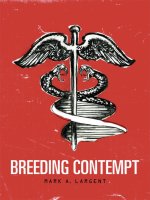rutgers university press breeding contempt the history of coerced sterilization in the united states nov 2007
Bạn đang xem bản rút gọn của tài liệu. Xem và tải ngay bản đầy đủ của tài liệu tại đây (2.59 MB, 229 trang )
Breeding Contempt
Prelims.qxd 6/20/07 10:20 AM Page i
Prelims.qxd 6/20/07 10:20 AM Page ii
The History of Coerced Sterilization
in the United States
Breeding Contempt
rutgers university press
new brunswick, new jersey, and london
Mark A. Largent
Prelims.qxd 6/20/07 10:20 AM Page iii
Library of Congress Cataloging-in-Publication Data
Largent, Mark A.
Breeding contempt : the history of coerced sterilization in the
United States / Mark A. Largent.
p. cm.
Includes bibliographical references and index.
ISBN 978–0–8135–4182–2 (hardcover : alk. paper)—ISBN 978–0–8135–4183–9
(pbk. : alk. paper)
1. Involuntary sterilization—United States—History.
2. Eugenics—United States—History. I. Title.
HV4989.L275 2007
363.9'7—dc22
2007000029
A British Cataloging-in-Publication record for this book is available from the
British Library.
Copyright © 2008 by Mark A. Largent
All rights reserved
No part of this book may be reproduced or utilized in any form or by any means, electronic
or mechanical, or by any information storage and retrieval system, without written permis-
sion from the publisher. Please contact Rutgers University Press, 100 Joyce Kilmer Avenue,
Piscataway, NJ 08854–8099. The only exception to this prohibition is “fair use” as defined by
U.S. copyright law.
Visit our Web site:
Manufactured in the United States of America
Prelims.qxd 6/20/07 10:20 AM Page iv
Dedicated with love and appreciation to my wife, Nancy
Prelims.qxd 6/20/07 10:20 AM Page v
Prelims.qxd 6/20/07 10:20 AM Page vi
Acknowledgments ix
Introduction: In the Name of Progress 1
1 Nipping the Problem in the Bud 11
2 Eugenics and the Professionalization
of American Biology 39
3 The Legislative Solution 64
4 Buck v. Bell and the First Organized Resistance
to Coerced Sterilization 96
5 The Professions Retreat 116
Conclusion: The New Coerced Sterilization
Movement 138
Appendix. Bibliography of Twentieth-Century
American Biology Textbooks 149
Notes 157
Bibliography 181
Index 201
vii
Contents
Prelims.qxd 6/20/07 10:20 AM Page vii
Prelims.qxd 6/20/07 10:20 AM Page viii
ix
I owe a tremendous debt of thanks to the many people who have helped me in
my career and in writing this book. My parents, Frank and Betty Largent, encour-
aged me to pursue my interests wherever they might lead me. My advisers, Andrew
Conteh at Moorhead State University, Constance Hilliard at the University of
North Texas, and especially Sally Gregory Kohlstedt at the University of Min-
nesota, all took a personal and sincere interest in my success. I would not have
completed any of my degrees without their attention and concern. Paul Farber,
Mott Greene, and Keith Benson have been my mentors since I left graduate
school. Together they helped me think about how my work fit into other schol-
arship and showed me how to make the transition from student to professor.
Throughout my education and early career I have had the great fortune of
becoming friends with a number of amazing scholars. My colleagues at the Uni-
versity of Minnesota’s Program in the History of Science; Oregon State Univer-
sity’s History Department; the University of Puget Sound’s History Department
and its Science, Technology and Society Program; and most recently at James
Madison College at Michigan State University encouraged my work on this sub-
ject. Among those who I want to single out for special thanks is John P. Jackson,
who was the first to read an entire draft of the book and whose many comments
and additions significantly improved it. John is the smartest person I know,
a brilliant scholar and a good friend. Jeff Matthews and Chris Young have been
longtime friends, and they both helped me complete this project. Chris listened
to long, convoluted explanations of what I thought I was trying to say, and he
provided me a title that helped clarify it all. Jeff took the time to read and com-
ment on the manuscript on short notice, and his suggestions substantially
improved it. Other friends and colleagues who deserve special thanks include
Erik Conway, Steve Fifield, Eric Berg, Kai-Henrik Barth, Ross Emmett, David
Sepkoski, Jennifer Gunn, Michael Reidy, Matt Zierler, Dan Kramer, Greg Elliott,
Julia Burba, Kristin Johnson, Rich Bellon, Nick Kontogeorgopoulos, Chris Foley,
Acknowledgments
Prelims.qxd 6/20/07 10:20 AM Page ix
and Doug Sackman. I also want to thank my students, many of whom I count
among my best critics and collaborators. In particular, Christine Manganaro,
Frazier Benya, and Jasmine Garamella, all of whom were my students at the Uni-
versity of Puget Sound, were particularly helpful as I gathered material for this
book. At Michigan State University, two professorial assistants, Jessica Ports and
Brittany Foley, tracked down and copied most of the source material for this
book, and Jessica suffered through a final proofread of the entire manuscript.
Other students, like Emily Carlson, helped by babysitting so that I could finish
the manuscript. I also owe a debt of gratitude to the American Philosophical
Society, especially Rob Cox, and to all the historians and archivists there who
have created a tremendous resource for those interested in the history of the
American eugenics movement.
My work seeks to build on what dozens of other excellent scholars have
already contributed to our understanding of the history of the American eugen-
ics movement and of coerced sterilization in the United States. There are several
whose work has been particularly influential on my scholarship, including Paul
Lombardo, Diane Paul, and Gar Allen, and they deserve special recognition. I
would also like to thank Leila Zenderland, who encouraged this book through-
out its development. Her suggestions provided valuable direction at the project’s
inception and at its conclusion. Any shortcomings in the book are, of course, my
responsibility.
Finally, and most significantly, I want to thank my wife, Nancy, to whom
I dedicate this book. Nancy and I met shortly before I started graduate school,
and she has been a constant source of inspiration and encouragement throughout
the fifteen years we have been together. She supported me through my education,
she has again and again listened to me ramble on about long-dead biologists,
and she has pushed me to think carefully about my research and the contributions
my work can make to the world. She has also given me the greatest gift of all, our
daughter, Annabelle. Thank you, Nancy.
acknowledgmentsx
Prelims.qxd 6/20/07 10:20 AM Page x
Breeding Contempt
Prelims.qxd 6/20/07 10:20 AM Page xi
Prelims.qxd 6/20/07 10:20 AM Page xii
1
American physicians coercively sterilized tens of thousands of their patients over
the last 150 years. Their efforts began around 1850, and by the 1890s the move-
ment had grown into a full-blown crusade to sterilize or asexualize people who
doctors believed would produce undesirable children. Even though they exerted
significant influence on American culture, physicians alone could not garner the
public support and ultimately the legislation necessary to allow them to coercively
sterilize the unfit. Shortly after the turn of the century, several other groups of
professionals joined them, including biologists, social scientists,and lawyers. Within
four decades, two-thirds of the states had enacted laws that required the steriliza-
tion of various criminals, mental health patients, epileptics, and syphilitics. By
the early 1960s, more than 63,000 Americans were coercively sterilized under the
authority of these laws.
What is known about the practice of compulsory sterilization in the United
States has generally been examined as part of the broader story of the American
eugenics movement, which has received considerable attention by historians,
cultural study scholars, journalists, and, on occasion, social and natural scien-
tists.
1
Most closely associated with the Nazis and World War II atrocities, eugen-
ics is sometimes described as a government-orchestrated breeding program,
other times as a pseudoscience, and often as the first step down a slippery slope
that inevitably leads to genocide. By the end of the twentieth century, the word
eugenics had become a slur, something to be avoided at all costs. Occasionally,
though, we still see attempts to resurrect the eugenics movement, such as Richard
Lynn’s 2001 Eugenics: A Reassessment, Nicholas Agar’s 2004 Liberal Eugenics: In
Defense of Human Enhancement, or John Glad’s 2006 Future Human Evolution:
Eugenics in the Twenty-first Century, but these books represent the extremes in a
conversation that typically depicts eugenics as deeply problematic.
2
Histories of coerced sterilization in the United States emerged in the 1960s,
and they placed responsibility for the movement on a few select men who had
In the Name of Progress
Introduction
Intro.qxd 6/20/07 10:52 AM Page 1
participated in the American eugenics movement. Charles Benedict Davenport
and his employee at the Eugenics Record Office (ERO), Harry Hamilton Laugh-
lin, are universally identified as the leaders of the American eugenics movement
and are often held personally responsible for the sterilization movement. Daven-
port helped organize a broad, loose collection of sterilization advocates, and his
work provided them a scientific legitimacy. His claims about the biological basis
of American degeneracy were supported by the research of other American biol-
ogists; in turn, Davenport provided these biologists with research facilities and
funding. Davenport’s authority among his colleagues was based on his ability to
raise large sums of money from philanthropists and to organize scientists, who
were notoriously inept at organizing themselves. His public authority was
founded on his notable scientific credentials and his willingness to offer stark
and often startling conclusions based on limited scientific research. His claims
simultaneously motivated the public’s concern about American citizens’ genetic
failings and encouraged even more contributions for basic scientific research that
patrons hoped would uncover problems and ultimately produce solutions for
them. Davenport’s protégé, Harry Laughlin, was the chief proponent of compul-
sory sterilization laws in the United States, and he wrote books and articles on the
subject and testified before legislators and judges. The two men provided scientific
authority to support the prejudices that had motivated earlier advocates of the
coerced sterilization of state wards.
Assigning responsibility for something as vast and influential as the American
eugenics movement to one man or even a small group of men is a vestige of what
historians ruefully call “great man history.” This approach chronicles the wondrous
achievements of the select few who steered our ships of state, led our armies, and
shaped our cultures. By the latter half of the twentieth century, such histories came
to be seen as passé, even dangerous according to some, because they inappropri-
ately and heroically credited all of society’s achievements to the work of a few sig-
nificant figures. Such narrow approaches to the past have since been replaced with
social histories, group biographies, and narratives that emphasize cultural trends
or the impact of particular events in shaping history. The history of eugenics and
the troubled history of coerced sterilization in the United States are just now begin-
ning to move away from “great man history” to describe the roles that many scien-
tists, physicians, and other social authorities played in advancing it. Support for
coerced sterilization was widespread, and actually still remains well supported in
many corners of American society. The sterilization movement was not isolated to
a few places, it was not an aberration, and it did not disappear after World War II.
In short, Davenport and Laughlin did not do it alone. In fact, it is difficult to find
many early-twentieth-century American biologists who were not advocates of
eugenics in some form or another.
Even extending responsibility beyond Davenport and Laughlin to include most
American biologists still does not adequately identify all those responsible for the
tens of thousands of coerced sterilizations. American biologists were merely one
breeding contempt2
Intro.qxd 6/20/07 10:52 AM Page 2
segment of a movement that included thousands of scientists, politicians, social
activists, philanthropists, educators, and assorted do-gooders, racists, and utopians.
Moreover, many biologists who supported eugenics actually opposed compulsory
sterilization, especially when it was performed to allow patients and inmates to
reintegrate into society. The public claims made by Davenport and his colleagues
most certainly helped motivate the wave of state legislation from 1907 to 1937 that
empowered American physicians to sterilize patients with or without their permis-
sion. But eugenicists were as much influenced by the cultures in which they oper-
ated as they were capable of influencing it. To understand the history of coerced
sterilization in the United States, we need to understand the relationships between
the leaders of the movement and their cultural, intellectual, and professional con-
texts. The influences that brought about compulsory sterilization laws existed sep-
arately from the individuals who advocated them, and they continued long after
the passing of Davenport and his generation of biologists.
One need not be an apologist to admit that the majority of sterilization advo-
cates were well-meaning professionals who saw in the operation viable solutions to
complex social problems and devastating physical ailments. It is easy to be presen-
tist about eugenics and to dismiss it as the product of quacks and racists. However,
in an age before antibiotics and insulin, before Western medicine’s therapeutic
capacities began to emerge, preventing the birth of individuals encumbered with
genetic ailments seemed the only humane and prudent cure to many of the pro-
fessionals described in this book. Davenport and his colleagues operated at the time
when medical doctors could do little more than comfort patients, amputate infected
limbs, and augment the body’s natural healing capabilities. Recognizing that a num-
ber of ailments, such as hemophilia, color blindness, and Huntington’s chorea, were
passed genetically from one generation to another, sterilization proponents seized
on the opportunity to prevent a great deal of suffering, expense, and social upheaval,
while at the same time furthering their professional status. But most advocates of
compulsory sterilization did not stop with genetic diseases; they also imagined that
certain behaviors, such as what they considered sexual perversions or criminality,
were likewise passed from parent to child either through genetic or cultural inheri-
tance. Laughlin, for example, believed that by sterilizing “socially inadequate citi-
zens,” authorities could solve any number of complicated social problems.
3
This is a story about how good intentions and professional authority can
produce horrible results. From the point of view of the twenty-first century, it
is a story that shows how American professionals dehumanized large groups of
people—be they gay, minority, physically or mentally ill, poor, criminalistic, sex-
ually deviant, or mentally challenged—and treated them in incredibly brutal ways.
It is a story about the hubris of professionals both yesterday and today. It is, quite
honestly, an attempt to spread the responsibility for the sterilization of tens of
thousands of mental health patients, welfare recipients, and prisoners off the
shoulders of a few select people. This book does not apologize for the eugenicists,
nor does it advocate a renewal of the eugenics movement. The purpose of this
introduction 3
Intro.qxd 6/20/07 10:52 AM Page 3
story is to demonstrate the power of professionals in American culture and to lay
bare our ongoing compulsion to locate the source of complex problems within
certain citizens’ testicles and ovaries.
A Word about Terminology
The terminology that medical providers, politicians, biologists, and social scien-
tists used in describing the mentally deficient, mentally ill, felons, homosexuals,
and the poor is distasteful and stigmatizing. Yet terms such as sexually and morally
perverted, degenerate, feebleminded, retarded, inferior, and unfit are employed in
this book not for shock value or because they are accurate and appropriate
descriptions. Rather, the use of archaic and often disturbing language is a recog-
nition that such words signified specific assumptions. Sanitizing their language by
translating offensive terms into contemporary labels would do much more than
merely lose the flavor of their discourse, it would camouflage some of the assump-
tions under which professionals labored. In addition, much of our currently
accepted language includes euphemisms that gloss over unpleasant realities or
particular difficulties in some citizens’ lives. In these cases, the earlier language
offers more candid descriptions of their challenges. Sometimes, though, earlier
vocabulary, such as “the crime against nature,” similarly obscures their original
meanings. In these cases, I will explain as best I can precisely what users of the
language meant in their adoption of particular terms.
4
We have not overcome the legacy to which earlier, harsher words alluded.
Cleansing our language does not necessarily purge underlying assumptions, but
it certainly does obscure them. The power of direct language, devoid of the jar-
gon on which professionals rely, was most powerfully demonstrated to me in an
encounter with a gay rights activist early in my research on the subject of coerced
sterilization. After I learned about his interest in Oregon’s compulsory steriliza-
tion laws, we met at a coffee shop in downtown Portland. A well-groomed, fit-
looking man in his early fifties and dressed in an expensive suit, he showed me a
stack of photocopies of records relating to sterilized prisoners. In the middle of a
busy coffee shop, he paged through them and described in graphic language the
crimes that the men had been convicted of committing. The locker-room lan-
guage he employed in discussing activities that are more politely and euphemisti-
cally described as “sodomy” or “the crime against nature” stood in stark contrast
to his professional appearance. It left me confused about his intentions and
embarrassed by the fact that his booming voice was easily overheard by everyone
in the coffee shop. Later, I asked a scholar who works on the history of sexuality
about the incident. He explained that some activists eschew contemporary
euphemisms because they obscure and thus demonize the activities the words
weakly describe. Instead, many activists employ graphic descriptions of sexual
acts that leave no room for prudish denigration of the sex lives of consenting
adults. To some degree, I have adopted this approach and use terms throughout
breeding contempt4
Intro.qxd 6/20/07 10:52 AM Page 4
the book that reflect the assumptions and words used by historical actors to por-
tray as vividly as possible their worldviews.
In general, I use the term sexual surgeries to refer to the procedures that pur-
posefully altered patients’ and prisoners’ sexual abilities, urges, or reproductive
potentials. The operations aimed at fundamentally restricting patients’ abilities
to procreate and in some cases even to participate in sexual activities. Whereas most
other surgeries, elective or otherwise, are intended to augment a person’s physical
abilities or preserve their life, the sexual surgeries on which I focus here generally
reduce patients’ abilities to engage in sexual activities. In the case of truly voluntary
sexual surgeries, the limitations that the operations create are desired by the
patients and enhance their qualities of life. However, with coerced sterilizations,
sexual surgeries eliminated patients’ abilities to procreate and in some cases
engage in sexual intercourse, often to the great regret of the targeted populations.
From the mid-nineteenth century through the late twentieth century, medical
authorities used a number of methods to asexualize or sterilize patients and a large
number of terms to describe the procedures. There were two different classes of
operations: the complete removal of sex organs and the more limited surgical pro-
cedures that rendered some or all of an individual’s sex organs inoperative. When
used by medical doctors, the term castration referred generally to removal of the
testes from a man or the ovaries from a women; in legislative and popular dis-
course, it was almost always called emasculation or asexualization. In the case of
men, all of these terms referred to the removal of the testes or amputation of the
testes and scrotum. Among professionals, the amputation of the testes and scrotum
was formally described as an orchidectomy or a testiectomy, dramatic surgeries
that were used from the late nineteenth century through the 1930s to treat, punish,
or control hundreds of rapists, child molesters, and men who engaged in activities
associated with homosexuality. There was some discussion at the turn of the cen-
tury of an operation called a spermectomy, in which the cordlike structure that
contained the vas deferens and its accompanying arteries, veins, nerves, and lym-
phatic vessels was severed. Both the spermectomy and the orchidectomy would
eventually eliminate the ability of a man to have an erection or to ejaculate. This
surgery was seldom performed in the context of eugenic sterilization, but it was
advocated throughout the 1890s by those who feared that merely sterilizing defec-
tives, especially rapists, would encourage increased deviant behavior. The most
common sexual surgery in men was the vasectomy, which was first used near the
end of the nineteenth century and popularized as a method to limit fertility with-
out hindering the patient’s ability to engage in sexual activity. Quite different from
castration, vasectomies were sometimes advertised as capable of increasing men’s
vigor, as was the case with the work done by Eugen Steinach in the early twentieth
century.
5
In the 1980s, a new form of castration, chemical castration, emerged and
became popular as both a punishment and a treatment for men convicted of sex-
ual offenses. In women, there were also two categories of sexual surgeries, a dra-
matic intervention that removed portions of the patient’s reproductive organs and
introduction 5
Intro.qxd 6/20/07 10:52 AM Page 5
a more limited operation that destroyed her power to procreate.Advocates of com-
pulsory sterilization who called for the asexualization or castration of women gen-
erally wanted the woman to undergo a hysterectomy, which consisted of the
removal of the uterus, or an ovarioectomy, removal of the ovaries, sometimes
called an oöphorectomy. Another less dramatic surgery involved severing or
removing the fallopian tubes, which was called a salpingectomy, tubal ligation,
fallectomy, tuberotomy, or tuberectomy. Similar to men, the more dramatic sur-
geries in women resulted in hormonal changes, while simple sterilization opera-
tions merely destroyed the patient’s ability to have children.
I use the term coerced sterilization in reference to the general movement among
American professionals to use sexual surgeries to solve complex and vexing social,
economic, and moral dilemmas. Notions of what was voluntary or involuntary
changed considerably throughout the twentieth century, especially with the emer-
gence of the Nuremberg Code in 1947 and the evolution of informed consent as
a vital concept in American medical care. Compulsory sterilization laws—the state-
by-state legal framework that brought about the coerced sterilization of prisoners,
mental health patients, and other wards of the state—first began to be debated in
the mid-nineteenth century. Coercion, on the other hand, could take many forms—
legal, economic, or social—and in some cases patients were coerced to “volunteer”
for the surgeries.
6
In discussing laws that mandated the use of sterilization or asex-
ualization by prison officials, asylum managers, physicians, and mental health care
providers, I use the term compulsory sterilization for two reasons. First, it is the term
generally used by twentieth-century advocates of legislation who employed sterili-
zation as a tool of social and biological improvement. Second, it calls attention to
the fact that sterilization laws allowed the state to use the full range of police powers
in compelling individuals to relinquish their reproductive abilities.
There were three fundamentally different eras in which American physicians
employed sexual surgeries, either asexualization or simple sterilization. In the first,
which began in the late nineteenth century and lasted until the turn of the twen-
tieth, the prevention of crime was the key motivating factor, and medical doctors
were by far the most aggressive proponents. Castration was the usual remedy,
and advocates used punitive and therapeutic justifications when they operated
on deviants. Unlike the claims made in previous histories of the American
eugenics movement or of coerced sterilization in the United States, these early
coerced sterilizations were not done “in the name of eugenics.”
7
Instead, physi-
cians offered punitive or therapeutic justifications for the surgeries. Crime was often
discussed in relation to a number of sexual perversions that were collectively
identified as a crime against nature or sodomy, which included bestiality, anal
intercourse, pederasty, and oral sex, and the laws were used to prosecute homo-
sexuals, rapists, and pedophiliacs.
The second era of sexual surgeries began shortly after 1900, when the American
eugenics movement emerged and exerted increasing influence on public discus-
sions about the use of sexual surgeries to improve Americans’ overall genetic quality.
breeding contempt6
Intro.qxd 6/20/07 10:52 AM Page 6
During this stage, American biologists joined physicians in advocating the use of
less intrusive sterilization operations to treat patients they believed were incapable
of responsibly using their procreative powers and to eugenically improve the
nation’s population. Biologists offered the movement scientific authority and the
apparent ability to prove physicians’ anecdotes about how successive generations of
degenerates were in fact caused by a family’s tainted heredity. Compulsory sterili-
zation attained its highest level of popularity in the 1930s. In 1937, for example,
Fortune magazine asked in its annual readers’ survey about sterilization: “Some
people advocate compulsory sterilization of habitual criminals and mental
defectives so that they will not have children to inherit their weaknesses. Would
you approve of this?” Sixty-six percent of the respondents believed that mental
defectives should be sterilized, and 63 percent favored sterilizing criminals. Less
than one in six respondents directly opposed sterilization.
8
The third and final era in the history of coerced sterilization began shortly after
midcentury, when increasing numbers of people demonstrated their resentment
to government’s intrusion into citizens’ reproductive lives and several professions
abandoned the movement. In the 1960s and 1970s, as older eugenic rationales
came under attack by activists, government coercion was replaced by the potential
of new tools—like amniocentesis, genetic screening, and legalized abortion—to
empower parents to make informed decisions about their offspring. Shortly
thereafter, the punitive justifications present throughout the first era reemerged.
In the 1980s, legislatures and courts again began employing sexual surgeries to
punish welfare recipients, rapists, and child molesters. As was the case a hundred
years earlier, many government officials believed that the source of complex social
problems was located within the genitals of certain citizens. Advocates of sexual
surgeries in the twenty-first century extend from district attorneys’ offices to the
highest levels of the federal government; when he was governor of Texas, Presi-
dent George W. Bush publicly supported the castration of a convicted child
molester to curb his degenerate impulses.
9
Coerced Sterilizations in the United States
As a percentage of the overall population, the number of Americans who were coer-
cively sterilized in the twentieth century was small. California was single-handedly
responsible for at least a quarter of the nation’s coerced sterilizations, yet 1942, the
state’s most active year, witnessed the sterilization of only 1 in every 5,800 citizens.
10
But viewed in aggregate terms, the number of Americans who lost their reproduc-
tive capacities under the coercion of state laws and institutional mandates is stun-
ning: more than 63,000 people. Coercive sterilization laws persisted longer than any
epidemic, and they disproportionately affected individuals in a few particular states.
California, Oregon, North Dakota, Kansas, Delaware, and Virginia were especially
aggressive in implementing their sterilization laws. Some states’ doctors, like those
in Illinois, Pennsylvania, and Kansas, did not wait for the passage of compulsory
introduction 7
Intro.qxd 6/20/07 10:52 AM Page 7
sterilization laws. They sterilized patients on their own authority, which confounds
both our notions of the importance of compulsory sterilization laws and our ability
to accurately tally the total number of coerced sterilizations in the United States.
In the history of coerced sterilization, several locales loom large. Physicians in
Texas were the earliest advocates of coerced sterilization. Michigan was the first state
to seriously consider legislation that would compel some of its citizens to be steril-
ized. Medical doctors, lawyers, judges, and scientists in Chicago were also early
advocates of sterilization, and between 1910 and 1930 they were among the most
ardent proponents of eugenic sterilization. California, by far, sterilized more of its
citizens than did any other state. In sum, over two-thirds of American states adopted
sterilization laws in the first four decades of the twentieth century. The widely
quoted number of 63,000 is probably not even close to the actual number of coerced
sterilizations because so many went unreported, occurred in states that had no legal
oversight of coerced sterilization, or were wrongly reported as voluntary when in
fact the patient or inmate was coerced by prison authorities or health officials.
Contrary to conventional wisdom, the American eugenics movement did not
end with the discovery of the Nazis’ atrocities during World War II, nor did the
practice of coerced sterilization. From the late 1940s through the 1950s, eugeni-
cally justified legislation to limit immigration persisted, hospitals and prisons
coercively sterilized record numbers of Americans, and educators in high school
and college biology courses continued to teach students how “a great reduction
in human suffering could be achieved” if it were possible to “decrease the num-
ber of afflicted individuals born in each generation.”
11
Far from receding, the
compulsory sterilizations continued throughout the postwar years, riding a wave
of enthusiasm for science and technology and benefiting from the goodwill most
Americans felt toward the medical community as a result of wartime advances in
research and public health.
Legal scholars and social scientists finally shifted their position on compul-
sory sterilization in the late 1950s and early 1960s. It took another decade before
Davenport’s successors, the next generation of American biologists, abandoned
their support for eugenics and coerced sterilization. Between 1968 and 1974,
American biologists began attacking eugenics as scientifically problematic and
socially unacceptable. In the 1970s, the writers of American biology textbooks
increasingly linked the American eugenics movement with the atrocities com-
mitted by the Nazis during World War II. Encouraged by an array of civil rights
movements—including the disability rights, patient rights, prisoner rights,
American Indian, and women’s movements, as well as demands from African
Americans for social and legal reforms—in the 1970s American biologists took
a strong position against eugenics and coerced sterilization.
By the early 1980s, the American eugenics movement was officially dead, and the
word eugenics had itself acquired derogatory connotations. Nowhere was this trans-
formation more obvious than in the definitions for the word eugenic in the 1993 edi-
tion of the Oxford English Dictionary (OED). In the examples that it provided from
breeding contempt8
Intro.qxd 6/20/07 10:52 AM Page 8
1916, 1934, and 1957, one of which referenced Davenport, the word was used simply
to describe anyone interested in the genetic quality of a given population. But in the
1989 example, the word eugenic was clearly a slur. The OED quoted an article from
Atlantic magazine:“We hope that Professor Herrnstein’s eugenicist jeremiad did not
make readers too anxious about America’s future.”
12
Americans obviously changed
what they meant by the word eugenic sometime between 1957 and 1989, but its sig-
nificance for the use of sexual surgeries in the twenty-first century is still unclear. As
long as we continue to imagine that the coerced sterilization of tens of thousands of
Americans was the responsibility of only a small number of evildoers, all of whom
are now dead, and that the scientific errors that supposedly brought about the com-
pulsory sterilization movement have been remedied, we are at serious risk of repeat-
ing grave mistakes. As genetic technologies grow increasingly powerful, prospective
parents are ever-enthusiastic about the ability of modern medicine to help them
produce healthy children, and political leaders continue to search for easy solutions
to complex social and economic problems, the assumptions on which the compul-
sory sterilization movement was founded will continue to threaten some Ameri-
cans’ basic civil liberties.
Breeding Contempt
The organization of this book follows the history of coerced sterilization in the
United States from the middle of the nineteenth century through the turn of the
twenty-first. For well over a hundred years, American legal, scientific, and medical
professionals advocated the sterilization of certain Americans to punish them, to
treat them for both real and perceived ailments, and to prevent them from pass-
ing their traits to the next generation. The story is presented chronologically,
beginning with a Texas physician’s failed campaign to pass a compulsory steriliza-
tion law in the 1850s and ending with current debates about the use of chemical
castration as a treatment and a punishment for sex criminals and as a way to
control the fecundity of welfare recipients.
The first chapter focuses nearly exclusively on American physicians and their
advocacy of sterilization to prevent crime and punish criminals. While a great deal
of attention has been given to American biologists and their advocacy of eugen-
ics, very little thought has been paid to the dozens of prominent medical doctors,
organizations, and journals that advocated coerced sterilization years before any
biologist took up the cause. American physicians were, in fact, pioneers in the
movement, and because they developed and performed the sterilization opera-
tions, they were vital to its practice.
Despite being overstated in the histories of eugenics, biologists did play a criti-
cal role in the emergence of compulsory sterilization laws in the twentieth century.
Chapter 2 explores their influence and the rewards they reaped for advocating
coerced sterilizations and participating in the American eugenics movement. In
the 1880s and 1890s, physicians were using anecdotal evidence to support their
introduction 9
Intro.qxd 6/20/07 10:52 AM Page 9
claim that human deficiencies had a genetic basis. The rediscovery of Mendel’s
work in 1900 and the creation of the Station for Experimental Evolution, the
American Breeders Association, and the ERO provided advocates of compulsory
sterilization laws with the scientific justifications needed to claim that social and
physical ailments had a hereditary basis.
The book’s third chapter analyzes the emergence, influence, and eventual demise
of compulsory sterilization laws in the United States. Histories of coerced steril-
ization have, because of the localized nature of the subject, tended to examine
single states or regions, while histories of the American eugenics movement often
gloss over local differences and make broad claims about its effects. Chapter 3
summarizes both the legislation in various states that allowed physicians to coer-
cively sterilize state wards and the court challenges to those laws.
The last two chapters explore the gradual emergence of professional resistance to
the use of sexual surgeries for eugenic, therapeutic, and punitive purposes. Public
health and the oversight of allied health professionals in the United States are both
constitutionally allocated to the states, rather than to the federal government. While
there is a general American eugenics movement and nationwide professional organ-
izations, coercive sterilization was in practice a decentralized activity. It was con-
trolled by state authorities and, more often than not, by institutional authorities.
Throughout the years between 1910 and 1930, opposition to compulsory steriliza-
tion laws was likewise decentralized and largely ineffective. This changed in 1927
with the release of Oliver Wendell Holmes Jr.’s majority opinion in Buck v. Bell, the
U.S. Supreme Court case that declared Virginia’s compulsory sterilization law con-
stitutional and created a national target that helped unite opponents. The immedi-
ate impact of Buck v. Bell was the crystallization of Catholic opposition to
sterilization. The professions that advocated eugenics and compulsory sterilization
did not entirely abandon the movement for several more decades.
The book concludes with a discussion of the ongoing attempts by American
activists, legislators, and judges to employ sterilization, either surgical or chemical.
The 1960s and 1970s witnessed the end of coerced sterilization in most places
around the United States and the abandonment of advocacy by every professional
group that had once campaigned for compulsory sterilization laws. That should
have spelled the end of coerced sterilization in the United States, but the movement
was resurrected at the end of the twentieth century by a new wave of anxieties about
certain citizens’sexual activities and by the invention of synthetic female hormones,
marketed as Depo-Provera and Norplant. Used in women, Norplant, which is
implanted under the arm, provides birth control for five continuous years, while
Depo-Provera is administered as a shot and prevents pregnancy for three months
after injection. Men who are injected with Depo-Provera are chemically castrated, as
the levels of testosterone in their bodies decline significantly. These two drugs
demonstrate that, far from ending coerced sterilization in the United States, the
advance of science and the development of new biotechnologies have made it even
easier to coercively sterilize problematic citizens in the name of progress.
breeding contempt10
Intro.qxd 6/20/07 10:52 AM Page 10
11
The first professionals to advocate coerced sterilization as a solution to America’s
social ills were physicians interested in reducing the incidence of crime, or,
more accurately, in reducing the number of criminals who produced children
who would themselves presumably demonstrate the weaknesses they inherited
from their parents. Degeneracy, transferred from parent to child through either
genetic or cultural inheritance, was a concept that drew increasing study through-
out the latter half of the nineteenth century. American physicians used the term
degenerate to describe anyone who exhibited diminished mental, moral, or sexual
capacities, and they believed that the sources of degeneracy were a combination of
biological and environmental factors.
1
The language used to describe such people
was often brutal and dehumanizing, and it reflected the subhuman status many
authors ascribed to the degenerate. Decades before any American biologist ever
advocated the study of eugenics, long before Francis Galton coined the word
eugenics, and even years before Charles Darwin published his theory of evolution
by natural selection, American medical doctors considered the merits of steriliz-
ing the nation’s degenerates as a method to penalize them, to prevent them from
committing future crimes, to reform them, and to prevent the propagation of
their kind.
The Memorial
The earliest American advocate of sexual surgery to control or eliminate social ills
appears to have been Gideon Lincecum. A prominent Texas physician and ardent
proponent of castration, Lincecum was decades ahead of most of his colleagues in
linking the topics of animal breeding, human health, and social policy. In 1849,he
authored a bill for the Texas legislature, which he called “the Memorial.” The bill
would have substituted castration for execution as penalty for certain crimes.
Lincecum published and mailed copies of it to nearly 700 Texas politicians, jour-
nalists, prominent citizens, and medical doctors. He described how the threat of
Nipping the Problem
in the Bud
chapter 1
Chap-01.qxd 6/20/07 9:59 AM Page 11
castration would serve the punitive purposes of deterrent and punishment at least
as well as execution, plus it would serve as a check on the criminal type by
preventing them from propagating their kind.
2
Written ten years before Darwin’s On the Origin of Species, Lincecum’s Memo-
rial demonstrated that even though Darwin’s work was used by some to justify
eugenics and coerced sterilization, evolutionary theory was not at all necessary
for the development of compulsory sterilization laws in the United States. Using
arguments that would become common among eugenicists half a century later,
Lincecum discussed how selective breeding could improve the human race by
preventing the lowest citizens of the state from reproducing.“Like begets like,” he
wrote to another physician.“The laws of hereditary transmission cannot be over-
ruled. When the horse and the mare both trot, the colt seldom paces.” Likewise,
he reasoned, these laws were applicable to breeding better humans: “To have
good, honest citizens, fair acting, truthful men and women, they must be bred
right. To breed them right we must have good breeders and to procure these the
knife is the only possible chance.”
3
Lincecum’s Memorial was widely discussed after being published in most
Texas newspapers and in the Colorado Democrat. Much to his dismay, the pro-
posal was generally rejected and often made the object of jokes. The bill was
introduced in the Texas state legislature in 1855 and again in 1856, and Lincecum
reported that the legislators “did it in a manner better calculated to excite ridicule
and opposition than a philosophical consideration of the matter.” Ultimately, the
Memorial was referred to the committee on stock raising. Lincecum responded
to the criticism and mocking dismissal of his plan with a joke of his own: the
Lincecum Law “can not progress as rapidly as it should without the aid of the
press But the Press must have the benefit of the purifying implement itself
before they can be moved to the advocacy of righteousness.”
4
As was the case in many other states, Texas judges, juries, medical authorities,
and vigilantes did not need the legislature’s approval to carry out coerced sexual
surgeries. In 1864, for example, a jury in Belton, Texas, found a black man guilty
of rape and sentenced him to “suffer the penalty of emasculation.”
5
From the
1860s through the 1880s, newspapers reported the castration of men who were
convicted of rape and of violent assaults on suspected rapists, almost all of
whom were African Americans. Likewise, authorities in Kansas, Oregon, Indi-
ana, Pennsylvania, and Illinois reported coerced sterilizations of prison inmates
and mental health hospital patients without the legal umbrella of compulsory
sterilization laws.
The first widely cited advocate of sexual surgeries as a solution to complex per-
sonal and social problems, and therefore an author we can justifiably identify as
one of the founders of the American sterilization movement, was Orpheus Everts,
the superintendent of the Cincinnati Sanitarium. In a paper presented to the
Cincinnati Academy of Medicine in 1888, Everts explained how he had “given the
subject of emasculation a good deal of attention in the course of twenty years’
breeding contempt12
Chap-01.qxd 6/20/07 9:59 AM Page 12









